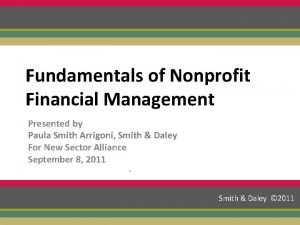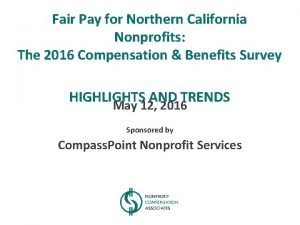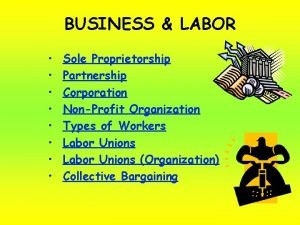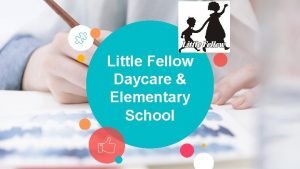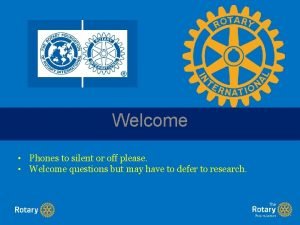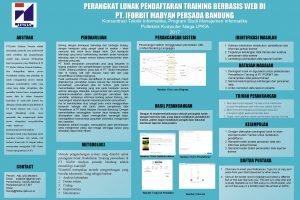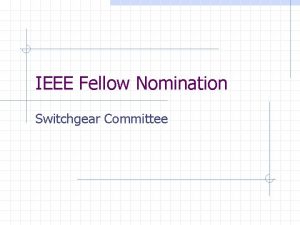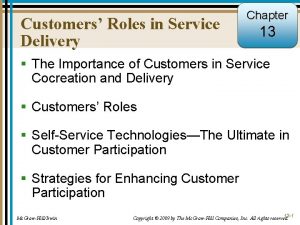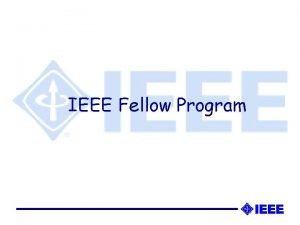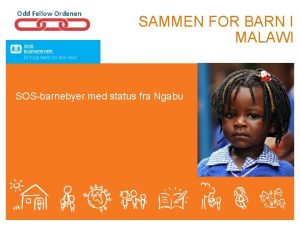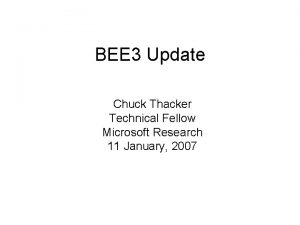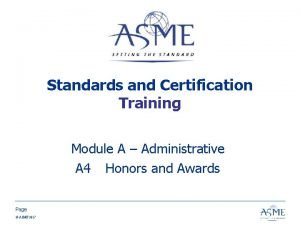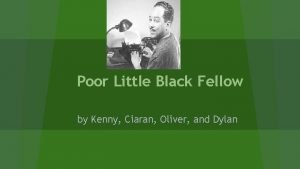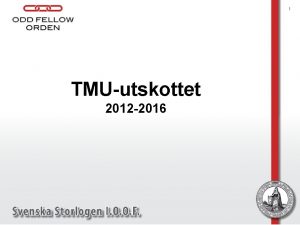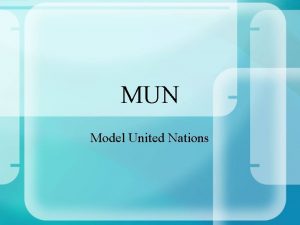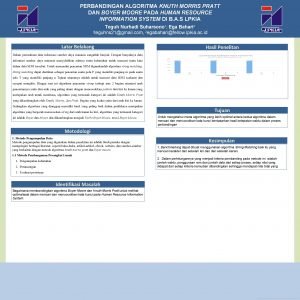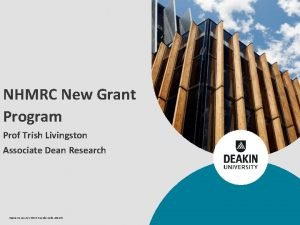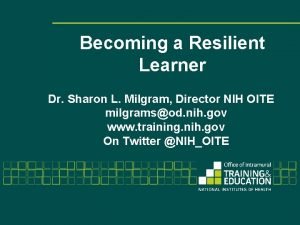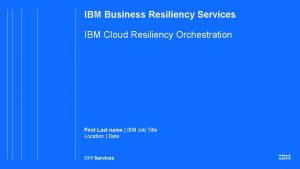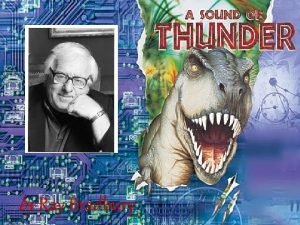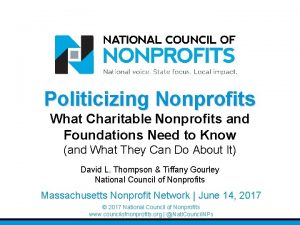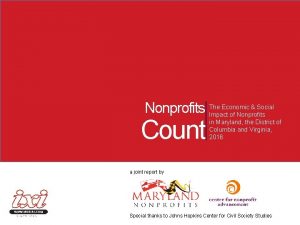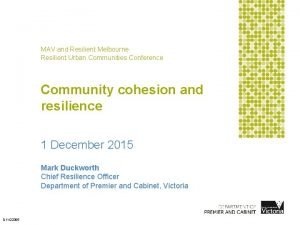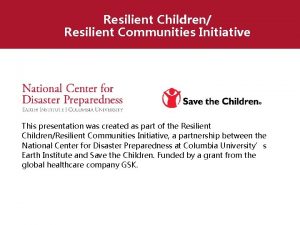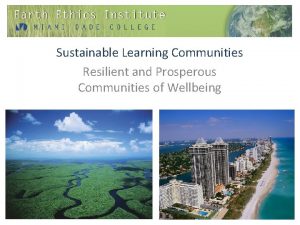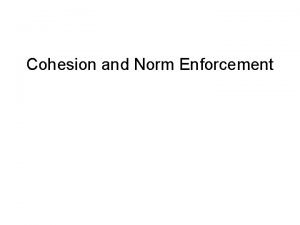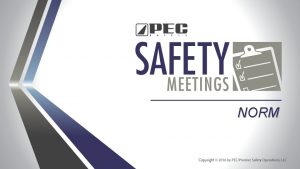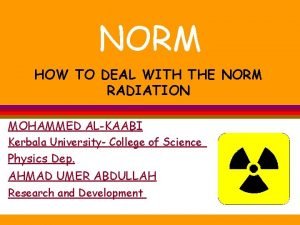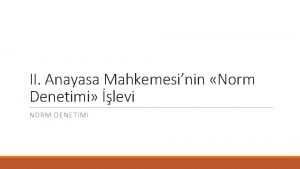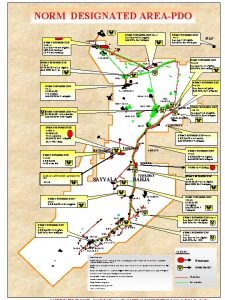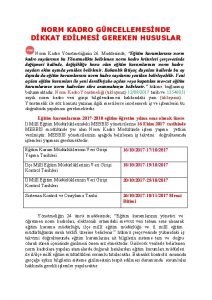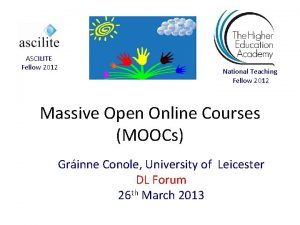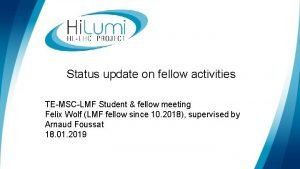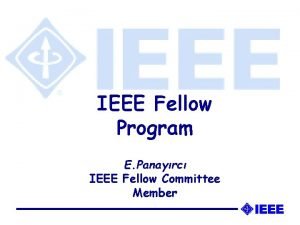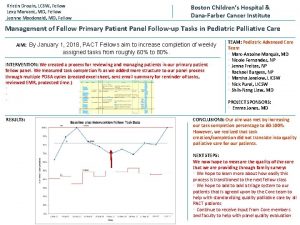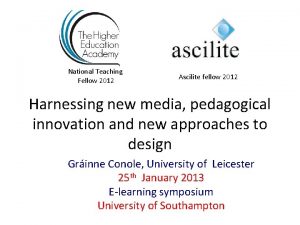Resilient Nonprofits Resilient Communities Norm Smith Senior Fellow























- Slides: 23

Resilient Nonprofits, Resilient Communities Norm Smith, Senior Fellow M. J. Murdock Charitable Trust Community Foundation of North Central Washington Sun Mountain, Winthrop, WA, October 1, 2014 Sleeping Lady, Leavenworth, WA, October 2, 2014

Overview • Who Is In The Room Activity • Profile of the Independent Sector • Collective Impact & Isolated Impact – Group Exercise (Time Permitting) • Resiliency • Appreciative Inquiry • Concluding Thoughts

PART I – WHO’S IN THE ROOM?

Mission Statements • TFFF: “Successful Citizens and Vital Rural Communities” • MJMCT: “to enrich the quality of life in the Pacific Northwest by providing grants and enrichment programs to organizations seeking to strengthen the region’s educational, spiritual, and cultural base in creative and sustainable ways; ” • PNCA: “Pacific Northwest College of Art prepares students for a life of creative practice. ”

PART II – PROFILE OF THE INDEPENDENT SECTOR

Bridgespan’s Key Findings • Spending – Does rural get its share? • Financial health – Are rural nonprofits better stewards? • Funding – Are rural nonprofits short on financial nutrients? • Leadership – Are rural nonprofits able to hire/retain top talent? • Distance – Are time and distance a rural hurdle?

U. S. Donors to Non-Profits Private Contributions by Source ($ in billions) Individuals $228. 96 72% Corporations 6% $18. 1 7% Bequests $23. 4 15% Foundations $45. 7 Total Giving: $316. 23 billion Source: Giving USA 2013, Giving USA Foundation, researched and written by the Center On Philanthropy at Indiana University

Part 2: The World of Grantmakers Revenue for Reporting Public Charities, 2010 Private Contributions 13. 3% Fees for Svcs & Goods from Private Sources 49. 6% Government Grants 8. 3% Fees for Svcs & Goods from Govt 23. 9% Investment Income 2. 8% Other Income 2. 1% Source: Nonprofit Sector in Brief 2012 National Center for Charitable Statistics, the Urban Institute

Contributed Time & Individual Dollars • About 25% of Americans over the age of 16 volunteer time worth over $225 billion annually for non-profit service • In recent years, individuals have given over $225 billion in cash contributions annually • Charitable contributions go predominantly to religious organizations (32%), educational institutions (13%), and human service organizations (13%)

The World of Grantmakers National Distribution of Grant Dollars International Affairs 5. 5% Science & Technology 2. 6% Religion 2% Social Sciences 1% Environment & Animals 7. 4% Education 23. 3% Public Affairs/Society Benefit 11. 8% Human Services 13. 1% Total Dollars = $22. 1 billion Health 22. 6% Source: The Foundation Center, Foundation Giving Trends, 2011 *Based on a sample of 1, 384 larger foundations

The World of Grantmakers Distribution of Grant Dollars by Western Foundations Public Affairs/Society Benefit 8. 1% Arts & Culture 7. 6% Science & Technology 3. 8% Religion 1% Social Sciences 0. 5% Health 30. 6% International Affairs 8. 2% Human Services 8. 6% Environment & Animals 8. 9% Education 22. 6% Total Dollars = $7. 8 billion Source: The Foundation Center, Foundation Giving Trends, 2011 *Based on a sample of 1, 384 larger foundations.

PART III – COLLECTIVE IMPACT & ISOLATED IMPACT

Five Conditions of Collective Success Common Agenda Shared Measurement Systems Mutually Reinforcing Activities Continuous Communication Backbone Support Organizations

Isolated Impact • Alone • Can be successful if a technical problem is well defined and the answer is known Adaptive Problems • Complex • No single entity has the resources to bring about the change and the answer is not known

Five Conditions of Collective Success Common Agenda Shared Measurement Systems Mutually Reinforcing Activities Continuous Communication Backbone Support Organizations

PART IV - RESILIENCY

Carlton Complex Fire Japan’s Tsunami

Oso, WA, Mudslide Oso, WA, Post Mudslide

Pilger, NB, Twin Tornadoes Vernonia, OR, Two 500 Year Floods in 11 years

PART V – APPRECIATIVE INQUIRY

Concluding Thoughts • “History is not, of course, a cookbook offering pretested recipes. It teaches by analogy, not by maxims. It can illuminate the consequences of actions in comparable situations, yet each generation must discover for itself what situations are in fact comparable. ” –Secretary of State Henry Kissinger • “There's an old saying about those who forget history. I don't remember it, but it's good. ” –Satirist Stephen Colbert

Congratulations to Chelan, Douglas, and Okanogan Counties’ Resilient Independent Sector Norm Smith Senior Fellow, M. J. Murdock Charitable Trust norms@murdock-trust. org

References & Reading • • • Bridgespan Article - http: //www. bridgespan. org/Publications-and-Tools/Funding. Strategy/Small-but-Tough-Nonprofits-in-Rural-America. aspx “Foundation Giving Trends” by the Foundation Center Giving USA 2013, Giving USA Foundation, Center On Philanthropy at Indiana University National Center for Charitable Statistics, the Urban Institute, Nonprofit Sector in Brief Core Files 2012 Current Population Survey, September 2013 Non Profit Almanac Stanford Social Innovation Review, Winter 2011, “Collective Impact” by John Kania and Mark Kramer of FSG, www. ssireview. org Stanford Social Innovation Review, Winter 2004, “Leading Boldly” by Ronald Heifetz, Kania and Kramer, www. ssireview. org Visit www. chalkboardproject. org Appreciative Inquiry - http: //appreciativeinquiry. case. edu/intro/whatisai. cfm Resilience – Community Vitality, Spring 2014, The Ford Family Foundation, www. tfff. org/cv
 Xerarch succession
Xerarch succession Finance fundamentals for nonprofits
Finance fundamentals for nonprofits Northern california nonprofit compensation survey
Northern california nonprofit compensation survey Crm for nonprofits open source
Crm for nonprofits open source Digital ecosystems nonprofits
Digital ecosystems nonprofits Kahoot nonprofit
Kahoot nonprofit Little fellow
Little fellow Paul harris fellow certificate template
Paul harris fellow certificate template Fellow lpkia
Fellow lpkia Ieee fellow nomination form
Ieee fellow nomination form Clarence filsfils
Clarence filsfils Importance of fellow customers in service delivery
Importance of fellow customers in service delivery Ieee fellow program
Ieee fellow program Odd fellow orden
Odd fellow orden Technical fellow microsoft
Technical fellow microsoft Asme fellow nomination
Asme fellow nomination Poor little black fellow
Poor little black fellow Odd fellow medlemsregister
Odd fellow medlemsregister Mun policy statement
Mun policy statement Fellow lpkia
Fellow lpkia Nhmrc emerging leadership fellow
Nhmrc emerging leadership fellow Sharon milgram
Sharon milgram Resiliency orchestration
Resiliency orchestration Great oiled resilient striding legs analysis
Great oiled resilient striding legs analysis

